Slam Bidding
A slam in bridge requires luck, strength and controls.
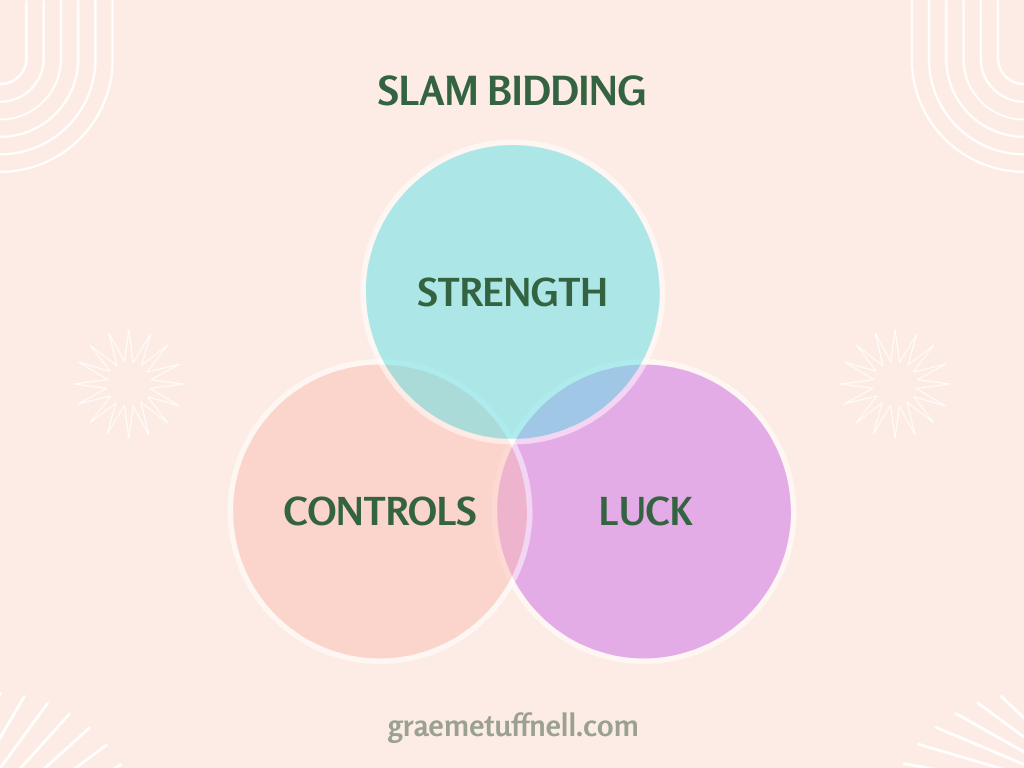
Luck or just playing the odds
On the following hand North opens a weak 1NT and South uses Stayman, finding the spade fit. South simply bids 6♠ which becomes the final contract. How many tricks you can make?
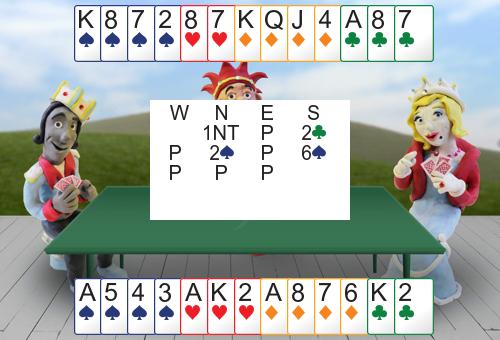
By ruffing the losing heart in the North hand, declarer seems to have an easy 12 tricks as long as trumps break 3-2. So this is a slam we'd definitely be pleased to be in.
Unfortunately, when the hand was played, trumps broke 4-1. That seems pretty unlucky but a 3-2 break only happens 68% of the time. 32% of the time this well bid slam is going to go down.
If you can get used to the idea that very few slams you bid will be 100% guaranteed and, instead, aim to bid slams that simply make more often than not you'll be better off in the long run than the overly cautious players. And you'll have more fun than they do!
Strength need to bid a slam.
Slam bidding is just like bidding to game only you need extra tricks. That might sound like an over-simplification but it's not a bad way to approach things.
33 points is enough for 6NT. There are no guarantess when you're bidding in bridge but with that strength you'll make your slam more often than not.
You can often make slam in a suit contract on 30-32 points but you'll need a good trump fit and good shape. Chances are that two balanced hands ith 30 points aren't going to be enough even if you do have a trump fit.
On the following hand North and South have a natural auction to slam.
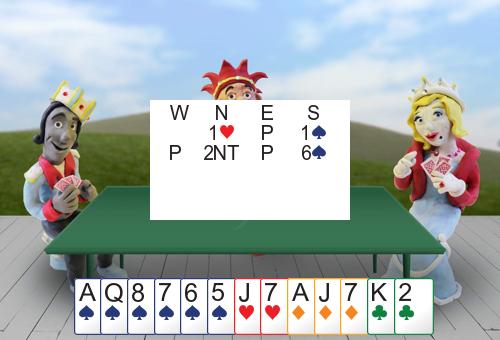
1♠ is a change of suit so it's forcing and it keeps the bidding low. That means North can't pass and is expected to describe his hand further which he does, in this case, with 2NT. That 2NT bid is a limit bid showing 18-19 points and a balanced hand. South has 15 high card points with good shape together with North's 18-19 making 33-34 between the two hands. North must have at least 2 spades for the 2NT bid so South can be sure of an 8 card trump fit. 33 points and 8 trumps.
Quantitative 4NT
Typically you need 33 HCP to bid a slam with two balanced hands because you don't have long suits to give you extra tricks. If you don't know if you're strong enough you can use the quantitative 4NT.
If the previous bid was 1NT, 2NT or 3NT then 4NT is quantitative. That's what they call it but it just mean invitational. Partner will either pass with a minimum or bid 6NT with a maximum. It's the same idea as inviting to game by bidding 2NT when partner opens 1NT.
Quantitative 4N 1N, 2N, 3N - 4N -- P = min -- 6N = max
North opens 2NT, a limit bid, to show 20-22 points and a balanced hand.

South invites to slam with 4NT. North is maximum for the 2NT opening and accepts the invitation. 6NT makes 6.
There are other sequences where you can use the Quantitative 4NT but you'll need some good agreements with your partner.
North and South are playing Acol so North's 1NT shows 12-14 points.
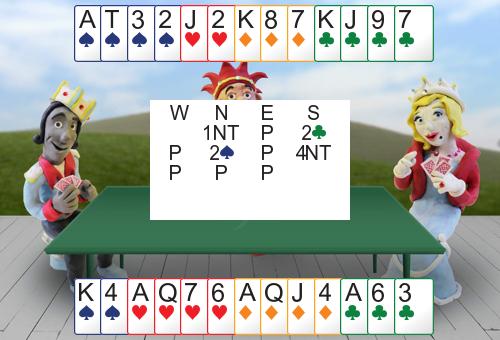
South starts with Stayman, looking for a major fit. North shows spades, not what South was hoping for. What's that 4NT bid mean now?
A useful agreement when partner shows a 4-card major after Stayman is that bidding the 'other major' agrees opener's suit as trumps. South, wanting to ask for Aces with spades as trumps, would therefore bid 3♥ first, the other major, and then 4NT. That means the direct jump to 4NT on the hand shown is still quantitative.
On the hand shown, North is minimum and so passes. 4NT is high enough even with all those points.
Controls
If you've decided that you're strong enough to bid slam then, on some hands, it's still possible that you might be missing two aces or the Ace and King in one suit. There are various conventions you can use to check.
Cue bidding
If you and your partner have already decided on a trump suit then bidding a new suit can be used to show first or second round control in the suit. That's an Ace, King, void or singleton.
Cue bids are made as cheaply as possible. If you skip over a bid then you're denying control in that suit.

North's 5♦ bid is a cue bid denying first or second round control in clubs. South bids 5♠, staying out of trouble.
Splinter bids
An unnecessary jump in a new suit can be used to show a singleton or void and a trump fit.
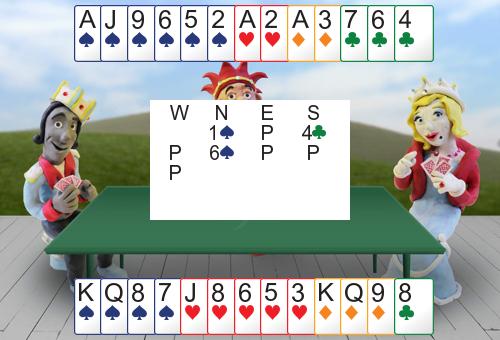
4♣ showed spade support and a singleton or void in clubs. North loves that news and 6♠ makes easily.
Gerber
The Gerber 4♣ convention asks for the number of aces in partner's hand.
4♣ Gerber - 4♦ = 0 Ace or 4 Aces - 4♥ = 1 Ace - 4♠ = 2 Aces - 4N = 3 Aces
Most experts rarely if ever use Gerber and if they do it's only over a 1NT or 2NT bid from partner. Using Gerber after 3NT will too often take away the meaning of a natural, forcing club bid.
Blackwood
The Blackwood 4NT convention is one of the most commonly used bridge conventions. Blackwood is used when you are thinking of bidding a slam and want to find out how many aces partner has.
It's no good launching into Blackwood unless you've already established partner's shape and strength. Think of Blackwood as a final check to make sure you're not missing two aces rather than something you do because you can't think of any other way to explore for slam.
4NT is not a bid you would normally make in a natural sequence which makes it easy to remember that something funny is going on!
4NT asking for Aces - 5♣ = 0 Ace or 4 Aces - 5♦ = 1 Ace - 5♥ = 2 Aces - 5♠ = 3 Aces
Notice that the responses start from the lowest available bid. After hearing partner's response you will normally now be in a position to decide whether or not to bid slam.
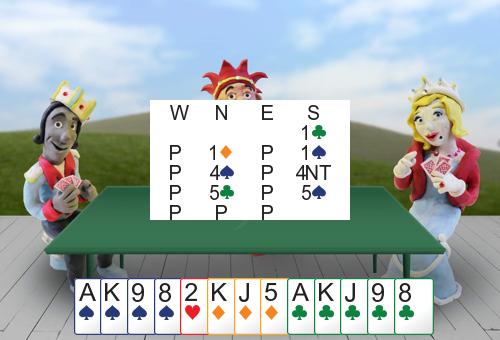
This hand has good trumps, honor cards in partner's suit, an excellent side suit in clubs and a singleton. Slam is a definite prospect. But partner has no aces, so slam is hopeless and you have to be content with 5♠ losing the ♥A and the ♦A.

This time North shows 1 Ace and South bids the slam.
Asking for Kings
If your side has all the aces, you might like to know how many kings partner has. You should only ask for kings if you are interested in bidding a grand slam, where you need all 13 tricks. Bidding 5NT promises that no ace is missing.
5NT Asking for Kings - 6♣ = 0 King or 4 King - 6♦ = 1 King - 6♥ = 2 King - 6♠ = 3 King
Roman Key Card Blackwood
With Roman Key Card Blackwood (RKCB), 4NT asks for 'keycards' which are the 4 aces plus the King of trumps. Subsequent bidding can sometimes be used to ask if partner holds the Queen of trumps.
4NT (1430) - 5♣ = 1 or 4 Key Cards - 5♦ = 0 or 3 Key Cards - 5♥ = 2 Key Cards, no TQ - 5♠ = 2 Key Cards + TQ
When you are going to play in a suit contract the presence or absence of the trump king and trump queen are almost as important as the four aces themselves.

5♠ shows 2 of the 5 key cards and the ♥Q.
Trump Queen Ask
After a 5♣ or 5♦ respose the next step asks about the Queen of trumps. Without the Queen responder returns to the trump suit at the lowest possible level. With the Queen responder bids an outside King or simply jumps in the trump suit.
RKCB subsequent bidding
Here are some more advanced ideas to use after the initial responses to RKCB. You can leave these until you've had plenty of practice with the basic concepts.
QASK - Trump Queen Ask
QASK 4N - 5♣/5♦ -- 5♦/5♥ --- return to trump suit = no TQ --- 5N = TQ + 3 Kings or 0 King + 3RC --- suit = TQ + King in that suit --- jump in trump suit = TQ + nothing else
KASK - King Ask
After any response, the next step that's not the trump Queen ask or sign off.
KASK Next step - suit = K - 5N = 3 Kings or 0 King + 3RC - trumps = No K
KASK2 - Second King Ask
Cheapest non-sign off after 1 king shown by responder.
nt - asks for any second King
suit - SSA
SSA - Specific Suit Ask
SSA - suit below trumps = that King instead - NT below trumps = 3RC - trumps = denies K - trumps+1 = Kxx(x) - trumps+2 = Kx - Raise = KQ any length
TRCA - Third Round Control Ask
Applies:
After all possible kings shown or in a suit where the K is shown or denied already
After any response if asker skips KASK or the KASK2 then a new suit is TRCA.
After KASK2
TRCA suit -1 = xx ( or x without 3 trumps ) -2 = Q -raise = QJ(x) -jump = x with 3 trumps -sign off in trumps = xxx(x) Jump in the trump suit = x with 3 trumps
3RC - Third Round Control
If asker has bid a side suit, shows that Q. If asker hasn’t, then it shows Q of responder’s side suit if any. Otherwise shows at least one third round control. ( any outside Q, xx or x )
tags: #slambidding
